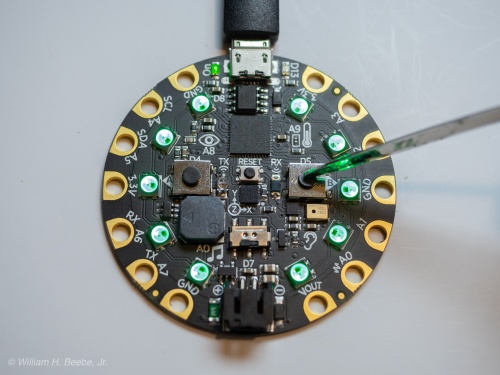
Prerequisites
A Raspberry Pi 3B+ or 4 with Raspbian Buster installed and connected to an Adafruit Circuit Playground Express via a micro USB to USB cable and with CircuitPython installed on the Circuit Playground Express (see working with the adafruit circuit playground express using the raspberry pi 4).
Circuit Python Programming Example 6
With the Circuit Playground Express still plugged in from Example 5, and with Example 5’s main.py running, we’re now going to run a Python application on the Raspberry Pi that reads the button presses from the CPE and displays them on the terminal. Here’s the code to run on the Raspberry Pi, named cpe-monitor.py:
#! /usr/bin/env python3## Circuit Playground Express example, Raspberry Pi side#import glob, serial, time, signal, sys# Use glob function to return all device file names of the form /dev/ttyACM*# I was supprised during development when /dev/ttyACM0 became /dev/ttyACM1# So we deal with the possibility of a name change in the last digit.# device = glob.glob("/dev/ttyACM*", recursive=False)[0]serUSB = serial.Serial(device, 115200, timeout=1)# Control C handler. Exit gracefully and close the USB serial device.#def sigint_handler(signum, frame):serUSB.close()print()sys.exit(0)signal.signal(signal.SIGINT, sigint_handler)# Tell the user what device name we're using, and perform a close and then# an open. Many times /dev/ttyACM* is already open when we get here.#print("Start monitoring output from Circuit Python Express on %s" % device)serUSB.close()serUSB.open()# Endless loop.#while True:usbdata = serUSB.read_until()# The USB serial device times out every second and returns if it has# not recieved any data.# If it does time out check for zero data returned.#if len(usbdata) > 0:# It's a byte array, convert to string and strip CR/LF.#print(usbdata.decode('UTF-8').rstrip())There are far more comments than there are actual lines of code. The key lines are 12,33, 39, and 43.
- Line 12 opens the USB connector as a serial tty device. The glob statement just above the open statement is due to the fact that it would appear that ttyACM0 isn’t cast in stone. During one run, for reasons I still don’t understand, /dev/ttyACM0 was replaced by /dev/ttyACM1.
- Line 33 reads in the data as a byte array,.
- Line 39 checks to see if real data has been returned. That’s because the USB serial line was opened in line 12 with a 1 second timeout. Timeouts are good because if there’s no activity you can exit and do something else. It’s a crude form of multitasking at the Python level.
- Line 43 prints out that data after converting the byte array received in line 33 into a string and stripping off any CRs and LFs from the end of the string.
A typical run looks like this. First the A and B buttons are pressed, then the switch is turned on and the A and B buttons are pressed again.
pi@raspberrypi:~/circuit-python-express $ ./cpe-monitor.py Start monitoring output from Circuit Python Express on /dev/ttyACM0Button A pressedButton A releasedButton B pressedButton B releasedButton A pressedSwitch onButton A releasedButton B pressedSwitch onButton B released
Not too much to get excited about yet. But think about how Python code other than the print() statement might make use of these simple strings. We now have an external input device, the CPE, telling the application running on the Raspberry Pi that events are taking place. Now all we have to do is open a serial channel on the CPE to read any data that the Raspberry Pi application might want to write back as some form of confirmation of reception.
Next time…

You must be logged in to post a comment.